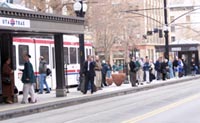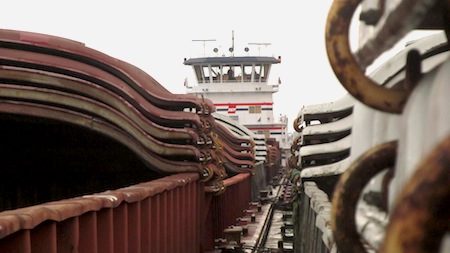SALT LAKE CITY —  In the 1990s, before one of the most successful and popular regional rapid transit systems in the United States was built at the foot of the Wasatch Front, the very same criticism of light rail and commuter rail now occurring in Detroit, and to some extent in Grand Rapids, was also heard here. It’s too expensive. Nobody will ride it. The region is too spread out. It makes no sense. Build highways not rail.Â
All this week I’ve ridden Salt Lake City’s 19-mile Trax light rail system, which opened in 1999, and now carries nearly 60,000 passengers a day. The system is fast, safe, convenient, and cheap. It cost $4 a day to ride anywhere, anytime. I didn’t need to rent a car. The light rail conductors care so much about their line that they pasted Valentine’s Day messages to riders on the windows.
Last year, ridership increased 23 percent, more than any regional rapid transit system in the country. People like rail so much that last November voters in Salt Lake County and neighboring Utah County approved a tiny sales tax increase (2.5 cents on a $10 purchase) to speed up construction on an extension, three brand new lines, and to double the length of a new commuter rail line that is set to open later this year. Suburban communities that were the most virulently anti-rail in the 1990s are clamoring to be the first to open new stations.Â
 As an icon of efficiency, usefulness, environmental-sensitivity, and metropolitan prosperity, regional rapid transit is hard to beat. That’s especially true when contrasting Michigan’s largest and sagging metropolitan region with the modern, fast-growing, clean and green cities of the West. A great train race has broken out across the Rocky Mountain region and the Pacific Coast, with cities challenging each other to build the best transit systems and to find new ways to raise money to do so, including taxing citizens and leveraging federal dollars.
As an icon of efficiency, usefulness, environmental-sensitivity, and metropolitan prosperity, regional rapid transit is hard to beat. That’s especially true when contrasting Michigan’s largest and sagging metropolitan region with the modern, fast-growing, clean and green cities of the West. A great train race has broken out across the Rocky Mountain region and the Pacific Coast, with cities challenging each other to build the best transit systems and to find new ways to raise money to do so, including taxing citizens and leveraging federal dollars.
Denver is building a 172-mile light rail, commuter rail, and rapid bus transit system. Portland last month opened a $57 million tram to add to its world-class system of light rail and street cars. Seattle is close to completing a light rail system and is already planning expansions and a street car. Phoenix is building its first line, and San Diego, San Francisco, Sacramento, and Los Angeles have systems in place and are in various stages of planning expansions.Â
While regional rapid transit systems do not, by themselves, ensure that regions can compete in the global economy, they are essential equipment for attracting the bright minds and active people who make regions prosper. In interviews here with young entrepreneurs, every one of them said that the Salt Lake region’s commitment to rail transit was a big factor in why they either built their companies here or relocated.Â
Just before the Super Bowl, Dave Barry, the Miami Herald columnist, lampooned Miami’s light rail system for its expense and low ridership. “It does not go to many other places that many Miami residents would like to go, which is why most of them do not use it,” Barry wrote. “To them, the Metrorail train is a mysterious object that occasionally whizzes past over their heads, unrelated to their lives, kind of like a comet.”
Miami’s transit problem results principally from poor planning and support. I hear the officials critical of rapid transit in Detroit cite Miami as an example of a system that is not working as anticipated. I remind them that people are pedestrians before and after they ride light rail. So to make systems work well zoning that encourages mixed use developments that connect people is just as important as economic investments that yield walkable destinations. It’s all in the linkages and connections.Â
The West’s cities understood that, and none more so than Salt Lake City. The light rail system, coupled with the 2002 Olympics held here, have given this region of nearly 2 million people a new view of itself as a global competitior. Incomes are rising. New companies are piling in here, particularly those in the recreational sports industry. Salt Lake City has a federal wilderness region at its doorstep, the only major metropolitan region in the country like that. And the city’s government has been led for nearly eight years by Rocky Anderson, a Democrat who has organized much of Salt Lake’s economic development strategy around the need to be more environmentally intelligent especially in reducing the production of global warming gases. Toyota hybrid Prius’s serve as municipal vehicles.
What is occurring here, the largest metropolitan region in the most conservative state in the country, is evidence of three things. First, rapid transit, environmental progress, and economic prosperity are tied together in ways that were foreseen long ago by visionaries, but are just coming to be fully realized in the dynamic cities of the American West. Second, these issues have transcended partisanship. And third, Michigan’s largest metropolitan region, and by extension the state, is far behind and losing ground in global competitiveness every day. Detroit has an opportunity to launch a commuter rail line to Ann Arbor that by itself won’t resolve the region’s massive economic migraine, but will go a long way to showing itself and the world that southeast Michigan is a place that matters.Â
